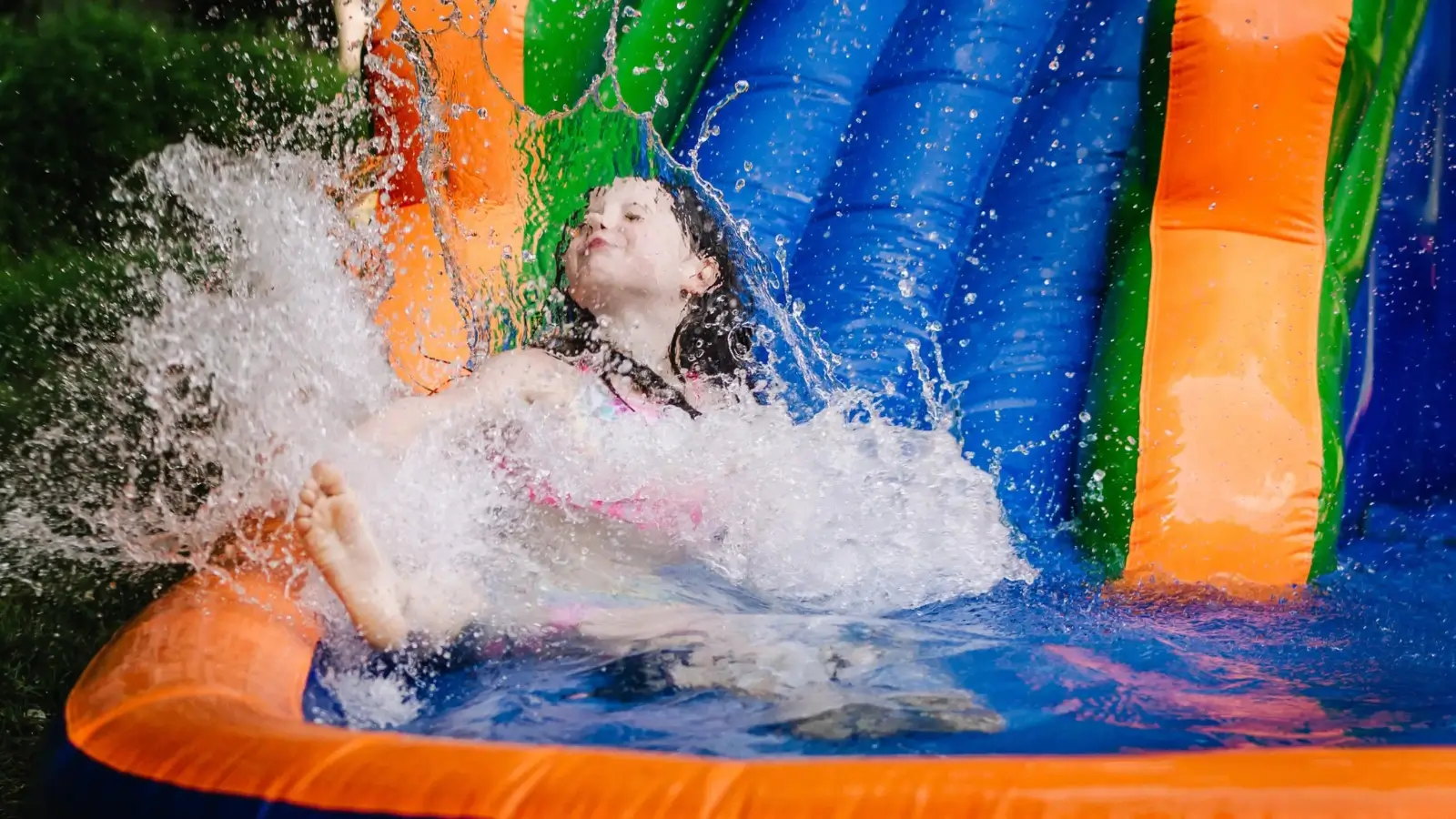


Inflatable rides were once dismissed as lightweight backyard toys, but the category has matured into a sophisticated, multimillion-dollar asset class that serves municipal recreation departments, luxury resorts, cruise lines, and event-rental companies in equal measure. The post-pandemic surge in outdoor activity, combined with society’s hunger for experience-based entertainment, has propelled demand for everything from toddler splash pads to towering inflatable water slides for adults that rival steel park rides in thrill factor. Crucially, capital requirements are modest compared with fixed structures; a slide that costs under US $10 000 can generate six-figure rental revenue within its first two peak seasons.
This article—well past the 2 200-word threshold—maps the opportunity landscape in detail. It examines market size, growth vectors, product typologies, cost structures, regulatory hurdles, marketing tactics, and emerging trends such as sustainable materials and IoT-enabled safety systems. By the end you will possess a step-by-step blueprint for launching—or scaling—a profitable venture centred on commercial grade products that deliver both fun and robust returns on investment.
Industry surveys peg the global water-slide sector at just over two billion US dollars today, with projections exceeding three and a half billion within the next decade. Inflatable models—not permanent fibreglass flumes—account for the fastest compound annual growth rate because they are easy to ship, store, and reconfigure. Operators can mount them on sports fields, hotel lawns, yacht decks, or city plazas in a matter of hours, then pack them away for off-season servicing.
Experience Economy Momentum: Consumers today prioritise memorable experiences over material possessions. Inflatable slides transform an ordinary venue into a pop-up water park, unlocking premium ticket pricing or event-rental fees.
Outdoor Wellness & Fitness: Climbing a thirty-foot structure and sliding down at speed burns calories and releases endorphins while imposing minimal joint impact. Adult-focused slides therefore attract fitness enthusiasts as much as fun-seekers.
Municipal & Corporate Spending: Cities are investing in portable leisure infrastructure to revitalise public spaces without committing to permanent construction. Corporations, meanwhile, embed inflatable attractions in team-building retreats and brand activations.
The casual observer often lumps all inflatables together, yet two distinct build standards exist: light residential models designed for a few weekend outings, and commercial grade products engineered to survive relentless, revenue-generating use. Core differences include:
|
Feature |
Residential |
Commercial Grade |
|
Base Fabric Weight |
10–12 oz PVC |
15–20 oz PVC or TPU |
|
Seams |
Single-stitched |
Triple-stitched or heat-welded |
|
Anchoring |
Basic tie-downs |
Reinforced D-rings, ground stakes, ballast pockets |
|
Blowers |
One small motor |
Redundant high-volume motors with safety cages |
|
Compliance |
None required |
Must meet international safety standards |
Entrepreneurs targeting serious revenue must default to commercial grade. Anything less attracts liability risk and accelerates repair costs.
Slides explicitly marketed for adults typically exceed 20 ft (6 m) in platform height, incorporate steep drop angles of 40°–50°, and feature wide dual lanes for racing scenarios. Because riders weigh more and descend faster than children, these units require heavier fabric, additional internal baffles, and larger splash pools to dissipate kinetic energy. Rental operators can charge 30 – 70 percent more for adult models while achieving similar set-up effort, driving superior margin.
Manufacturers increasingly offer hybrid designs—slide plus obstacle course, or slide plus bounce house—that extend dwell time and perceived value. At the top end, modular inflatable parks stitch multiple slides, trampolines, climbing walls, and floating docks into a single interlocking system. Resorts employ these as turnkey attractions that can be themed for holidays, music festivals, or branded sponsorships.
Polyvinyl chloride (PVC) remains the default fabric, but thermoplastic polyurethane (TPU) is gaining share thanks to its higher abrasion resistance, lower environmental impact, and recyclability. Water-based inks reduce volatile organic compounds during manufacturing. Some suppliers now blend recycled ocean plastics into the weave, enabling eco-marketing narratives that resonate with municipalities and cruise lines seeking greener credentials.
Smart blowers fitted with pressure, temperature, and vibration sensors can trigger automatic shut-offs or mobile alerts if conditions become unsafe. RFID tags stitched into anchor points assist with inventory management and proof-of-inspection logs. Early adopters report fewer insurance claims and smoother multi-unit logistics.
The simplest path is to buy one or more slides and rent them to birthday parties, school carnivals, corporate picnics, or wedding receptions. A mid-size dual-lane slide costing US $7 500 rents for US $600–700 per day, including delivery and staff supervision. Forty bookings per season equate to roughly US $28 000 gross revenue—enough to retire the asset within months. Add complementary inventory such as dunk tanks or foam cannons, and you can bundle packages to lift average order value.
Water-park operators, family entertainment centres, and cruise ships install permanent inflatable zones and charge per-ride or all-day wristband fees. A single high-thrill slide can handle 150 riders per hour. At five dollars per ride, the unit yields over US $3 000 in a single busy day. Because power draw is low—a 2 hp blower consumes less electricity than a hair dryer—operating margin remains high.
Super-yacht owners purchase custom slides, often branded with vessel names and colour-matched to hull paint. Prices stretch from €5 000 for a compact stern slide to €250 000 for full “beach club” suites that include lounging platforms, walkways, and netted swimming pools. Charter brokers recoup costs via higher weekly rental fees and improved customer satisfaction scores.
Savvy entrepreneurs monetise beyond rentals by offering:
Off-season warehousing in climate-controlled facilities
Scheduled cleaning, inspection, and repair services for other operators
Staff training and certification programmes
Resale brokerage for used commercial grade products
These lines diversify income and stabilise cash flow across low-season months.
Expect to pay:
US $2 000–3 500 for a 15-ft kiddie slide
US $5 000–8 000 for a 22-ft dual-lane unit
US $9 000–12 000 for a 30-ft, adult-rated giant slide
Sea-freight for a 20-ft container can run US $3 000–5 000 depending on origin port and fuel surcharges, though many US and European factories now hold stock domestically.
Storage: Climate-controlled warehousing at US $8–15 per square foot annually preserves fabric integrity.
Maintenance: Replacement blower bearings, anchor straps, and vinyl repair kits average 2 – 3 percent of equipment value per year.
Liability Insurance: General policies cost US $300 up to US $1 500 yearly for coverage of one to five units; rates climb with platform height and rider capacity.
Transport & Labour: Box trucks or trailers, plus at least two trained crew members, must be budgeted into every booking quote.
Regulatory Fees: Some jurisdictions impose inspection or permit charges per installation event.
Ignoring these items often leads to under-pricing and cash-flow surprises; build a safety margin of 25 percent into all projections.
The gold standard for inflatable amusement devices is ASTM F2374, which prescribes rules for design, fabrication, operation and maintenance. European operators follow EN 14960, while Australia relies on Standards Australia AS 3533 alongside state and territory Work Health & Safety codes. Securing insurance and venue approval is virtually impossible unless a slide meets or exceeds these benchmarks.
Sudden wind gusts lifting inadequately anchored units
Overloading when supervisors fail to control rider numbers
Power interruptions that trigger partial deflation mid-ride
Improper participant behaviour—somersaults, chain sliding or jumps from unsafe heights
Mitigation is rooted in best-practice anchoring, redundant blowers, real-time weather monitoring, trained supervision and crystal-clear signage. Accident data show that operator error and weak anchoring—not product failure—cause the majority of injuries.
Insurers scrutinise claims histories, inspection logs and staff certifications. Operators who keep digital maintenance records, run daily pre-opening checks and employ smart-sensor blowers often earn double-digit premium discounts. Many venues insist on being listed as “additional insured” before signing a hire contract.
Family events: birthdays, school fairs, church gatherings
Corporate functions: team-building retreats, staff-appreciation picnics
Fitness and wellness groups: boot camps seeking low-impact cardio options
Tourism venues: resorts, campgrounds, cruise ships and holiday parks
Luxury consumers: yacht owners, private-island resorts
SEO and keywords – Optimise pages for phrases such as “inflatable water slides for adults” and “giant inflatable slide rental,” paired with local place names.
Social proof – Post client testimonials and high-resolution action shots; slides are inherently shareable.
Video content – A 30-second clip of riders racing down a dual-lane slide can achieve viral reach on short-form platforms.
Online booking – Real-time reservation software captures impulse purchases and reduces admin friction.
Event planners, party-rental aggregators and municipal parks departments can supply consistent bulk bookings. Offer commissions or co-branding packages to secure exclusivity.
Thermoplastic polyurethane (TPU) and recycled fabrics are moving mainstream, backed by solar-powered production lines and end-of-life recycling programmes. Proven carbon-footprint reductions can unlock eco-sensitive venues and sponsorship deals.
Networked blowers will stream usage data to cloud dashboards, enabling predictive maintenance, tighter staffing models and automatic compliance reporting. Gamified leaderboards—using RFID or timing gates—encourage repeat play and social sharing.
Slides shaped as pirate masts, space rockets or jungle temples create immersive story worlds that stand out in crowded tourist markets. Projection mapping and LED lighting extend usable hours into dusk, adding evening revenue streams.
|
Stage |
Key actions |
Deliverables & KPIs |
|
Market validation |
Analyse demographics, climate patterns and local event calendars; interview venue managers. |
Demand forecast, target booking volume, break-even timeline |
|
Capital budgeting |
Secure finance or leasing; earmark roughly 60 % for equipment, 20 % for marketing and 20 % for contingency. |
Detailed CapEx/OpEx spreadsheet, funding approval |
|
Compliance setup |
Acquire ASTM-compliant manuals, draft risk assessments, register equipment where required. |
Operations handbook, inspection certificates |
|
Insurance and legal |
Obtain at least US $1 million general liability; create rider waivers and venue agreements referencing relevant standards. |
Policy certificate, legal templates |
|
Pilot season launch |
Deploy three units—a small combo, mid-size family slide and adult-rated racer—to gauge price elasticity. |
Booking log, customer-feedback scores, ROI checkpoint |
|
Scale-up and diversification |
Reinvest roughly 30 % of profit in extra slides or modular park sections; add warehousing and cleaning services. |
Expanded inventory, utilisation rate above 70 % |
|
Exit or expansion |
Explore franchising, regional roll-up acquisition or a pivot into bespoke luxury builds. |
Valuation model, prospectus, investor deck |
Inflatable attractions blend tangible assets with the emotional pull of shared adventure—an irresistible match for today’s experience-driven economy. Compared with permanent water-park infrastructure, start-up costs are modest, yet revenue potential is substantial; well-run fleets of commercial grade products often break even within a single peak season and retain healthy resale value.
Commitment to commercial grade quality to minimise downtime, liability and customer disappointment.
Disciplined risk management that treats safety codes and insurance as competitive advantages.
Relentless marketing execution through social channels, strategic partnerships and keyword-rich content that keeps the brand top of mind whenever the sun shines.
Entrepreneurs who master these fundamentals—and stay alert to sustainability advances and smart-sensor technology—can ride a profitable wave in the evolving amusement landscape. Whether you are launching your first business or expanding an existing portfolio, inflatable water slides offer a scalable, versatile and delightfully fun path to growth.